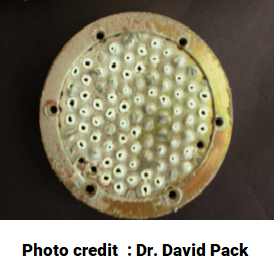10 December 2023| By Abdullah Hussein
One of the issues that frequently overlooked in flow assurance narratives is the elemental sulfur deposition (ESD) , although it has deleterious impacts on production operations.

Fig.1: elemental sulfur deposits
The implications of Elemental sulfur on production include :
- Flow restrictions and blockages.
- Equipment impairment and failure.
- Pipe piercing.
- Severe Corrosion problems. Many mechanisms have been suggested for corrosion including: acidification, and electrochemical mechanisms.
Natural gas is produced and transported with various amounts of sulfur containing components including H2S, mercaptans, and also elemental sulfur in the vapor phase. When the conditions change, the elemental sulfur deposits in a solid phase (S8), causing the aforementioned damages.
Fig.2: elemental sulfur structure
Many different mechanisms have been proposed to explain the deposition of elemental sulfur such as
Chemical reactions:
This is not likely to be the main cause of ESD, but it does serve as a source of elemental sulfur in the fluid stream. Examples of reactions that generate elemental sulfur include the following:
- Oxidation of H2S.
- Decomposition of polysulfides and sulfur containing compounds.
- Bacterial sulfate reduction.
- Thermochemical sulfate reduction.
Condensation:
When pressure drops, liquid hydrocarbons rich in sulfur are formed, and sulfur slowly deposits as the liquid evaporates, leaving solid particles behind.
Desublimation:
This is the most common mechanism of elemental sulfur deposits formation, wherein natural gas rich in sulfur goes through pressure and temperature changes, leading to sulfur solid particles formation.
ESD is affected by many factors, including:
- Pressure
- Temperature
- Gas composition
- Production regime/rate
ESD mitigation by controlling the above parameters, for example :
- keeping pressure and temperature above ESD formation boundaries.
- Using filtration systems. A drawback of this method is that filters impose pressure drop, which might make the problem worse.
- Application of heat to remove the formed ESD, but this might not be practical since the required heat is usually high.
- Solvents such as carbon disulfide are commonly used to remove ESD, usually injected at high temperature to improve the dissolution efficiency.
Elemental sulfur deposition